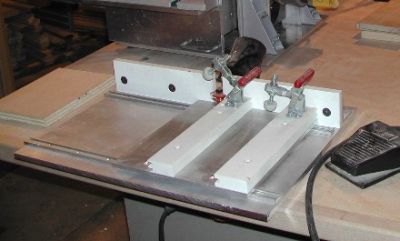Question
Does anyone use a shaper to cut face frame tenons? We have been using the table saw and the dado blades to cut face frame tenons and have been thinking about changing over to the shaper. Using the shaper would give a uniform thickness to the tenon and the variation in lumber thickness would not matter. We would have to change the way we cut mortises and only haunch the top and bottom rails so that there is no blow out of the stiles. We would also have to be accurate on the stop and start point of the mortise so that the mortise hole would barely show, because the tenon would be the same width as the mortise. It should be the same thing as cutting the cope on doors, only on a larger scale using straight cutters. Any experience in this matter would be helpful.
Forum Responses
(Cabinetmaking Forum)
From contributor K:
I thought about it about 15 years ago and tried it with cutters from a shaker door set. The problem I found immediately was making the extra cut on the two edges of the tenon. Then I still needed to buy a mortiser. I finally decided to go with a Multi-Router and cut slot mortises and make my own loose tenons. This way, you can make easy mortises of any needed size on the end grain as well as the edges. I cut 1/4" x 1" slots for everything. My standard face frame is 1 1/2", so a 1" tenon gives me a 1/4" shoulder on all sides. If I have a face frame, say 2 1/2" wide, I lay out for 2 tenons spaced 1/4" in from the edge of the frame, which would leave a 1/4" space between them. I make my own loose tenons to match them in bulk. I use poplar for the tenon stock and run about 50 ft. of 1/4" x 1". I bullnose both edges, then cross cut on the tablesaw sled to just under 1.5" long. This makes about 350 loose tenons which will go a long way. I cut 1/4" x 1" x 3/4" deep mortises. I have made setup jigs and milling fixtures for the Multi-Router to make the slotting process fast. I have even set up a fixture for making the haunches for beaded face frames using a 45 degree flat bottom chamfer bit without a bearing. The thing I like most about this process is that I cut the face frame parts to finished length and I have no worries of openings changing size when cutting a tenon too long or too short. I also purchased a glue system from Colonial Saw which allows me to insert a shaped glue tip into the mortise and inject a registered amount of glue with no hassle and very fast. Multi-routers aren't cheap but I found it well worth the investment.

Comment from contributor A:
Why use a shaper when a table saw is perfectly fine? A quick and accurate way to make tenons on the table saw is to use your dado end blades with a spacer in the middle sized for your tenon (would be oversized to account for width of teeth). Run your pieces through upright with a tenoning jig (either shop made or after market). Register your face off the jig and the tenons come out perfectly aligned. Cut the shoulders with a miter sled setting the tenon against a block of wood clamped to fence behind the blade to ensure same depth on both sides. Cut the top shoulder at the same time and hand saw your tenon to width. Make a haunch as you usually do.